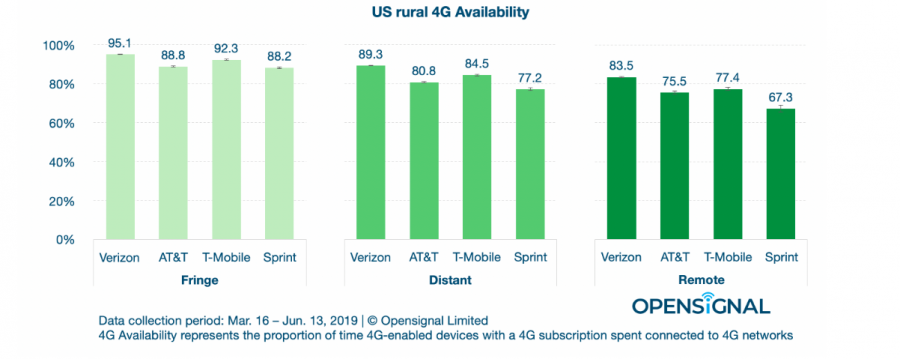Distance to urban areas is a key factor determining the experience rural users will have, OpenSignal says
How well are mobile networks working for rural U.S. residents? OpenSignal said that there are two primary factors in rural mobile network experience: the proximity of the area to an urban center, and the mobile operator — but in general, even in the most rural parts of the U.S., its rural 4G users “could on average spend the vast majority of their time connected to 4G across all rural regions, even in those locations far away from densely populated areas.”
OpenSignal, which leverages crowd-sourced, device-based data for its analysis, classified rural areas as ranging from Fringe to Distant to Remote, using a framework developed by the National Center for Education Statistics for U.S. locales. Verizon users had the “highest rural 4G Availability in all rural regions and were the only ones who spent more than 80% of their time on 4G networks across all types of rural area, even in the Remote rural areas,” OpenSignal said.
In Fringe locales near urban areas, T-Mobile US users also spent more than 90% of their time on LTE, OpenSignal reported. In Distant and Remote areas, T-Mo users still had higher LTE availability on average than Sprint and AT&T users, the company found.
AT&T narrowly beat out its other three national competitors for the fastest average download speed in Fringe areas (20.2 Mbps), and its speed lead widened in Distant areas (15.0 Mbps compared to second-place T-Mo with 14.1 Mbps) and Remote areas (14.6 Mbps for AT&T and 13.6 Mbps for T-Mobile US).
Unsurprisingly, the more remote the area, the slower the average network speed.
“Most of our users experienced average download speeds close to 20 Mbps in the Fringe locales, decreasing on average by 4.8 Mbps in Distant locations, and [decreasing] an additional 1.3 Mbps in Remote rural areas,” OpenSignal said.

With that caveat, Verizon had the fastest average upload speeds across all rural mobile networks, while AT&T won out with the lowest latency. Sprint generally lagged in performance behind the other three national carriers in all of the categories — but even in categories such as LTE availability, when OpenSignal users had a Sprint signal, they were connected to LTE about two-thirds of the time even in the most remote areas.
About 60 million people, or 19.3% of the U.S. population, live in rural areas. Read the full results from OpenSignal here.
In other test news:
–Spirent Communications tested audio quality on LTE devices in noisy public safety scenarios, such as near a running fire truck pump and during an alarm. Read the full story here.
–Keysight Technologies announced an extension of its existing relationship with Qualcomm Technologies aimed at speeding up commercialization of Dynamic Spectrum Sharing (DSS) technology.
By 2020, the test company said, mobile operators are expected to start implementing DSS on existing LTE base stations in order to accelerate nationwide 5G deployments, including in rural areas. DSS, it explained, “allows mobile operators to transform LTE base stations via a software upgrade to create hybrid 4G/5G base stations. … DSS enables a mobile operator to flexibly use existing spectrum allocations across low-, mid- and high- frequency bands by dynamically switching between LTE and 5G NR coverage based on traffic demand. Mobile operators can leverage DSS to deliver the best possible performance and coverage for a mix of 4G and 5G devices.”
The two companies have been collaborating on 5G-related work for a number of years, and Qualcomm will use Keysight’s 5G emulation capabilities in the development of DSS.
Keysight also this week said that Tech Mahindra will offer Keysight’s 5G protocol and radio frequency/radio resource management carrier acceptance toolsets to communication service providers and telecom equipment manufacturers as they develop and deploy new 5G handsets.
In addition, Keysight welcomed four new companies to its OpenTAP open-source testing initiative: 5G-VINNI, Page Electronica NV, TandM Solutions and Tokalabs.
–Anritsu launched two pocket-sized spectrum analyzers that support millimeter wave frequencies. The additions to the Spectrum Master MS2760A spectrum analyzer line have coverage from 9 kHz to 170 GHz, and the new Spectrum Master MS2762A model with increased sensitivity has coverage from 6 GHz to 170 GHz for the most demanding sensitivity requirements.
The test company also introduced a new opto-electronic network analyzer system, the ME7848A modular system that integrates Anritsu’s VectorStar vector network analyzer with an optical-to-electrical calibration detector and electrical-to-optical converters for E/O, O/E and O/O measurements on optical devices operating at 850 nm, 1310 nm, and 1550 nm.
–Kaelus’ Analyzer Calibration Extender now has the ability to self-calibrate in the field for the company’s Range-to-Fault module for locating passive intermodulation and return loss faults in radio frequency infrastructure. The calibration extender unit calibrates Kaelus equipment within about an hour and extends the time when instruments have to be sent off for more extensive calibration.
–National Instruments has launched a new platform for 5G cellular vehicle-to-everything testing, its S.E.A. C-V2X Open Loop test system. NI is collaborating with German test company S.E.A. Datentechnik GmbH, one of its Alliance Partners, on the new testing platform for OEMs and Tier 1 suppliers. For C-V2X to work, NI said, companies in the automotive ecosystem “will need to standardize on communication, understand how systems from multiple vendors interact and characterize behavior in real-world scenarios.”
The system combines software from S.E.A. with software-defined radio hardware from NI that sends real RF and GNSS signals to C-V2X controllers and telematics units, NI said.
“Road tests are valuable, however, proving performance in the lab helps teams iterate faster and have higher confidence in the device operation under a broader set of scenarios, including hard-to-reproduce corner cases,” said Gerd Schmitz, PhD, who is CEO of S.E.A. Datentechnik GmbH.

